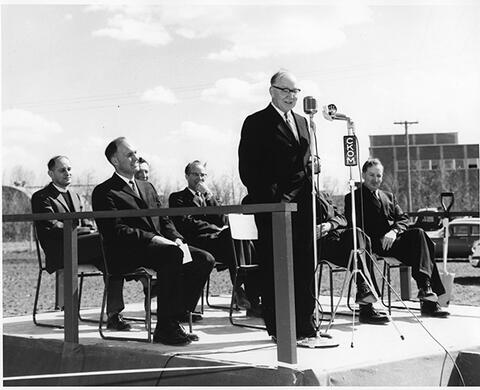
Title and statement of responsibility area
Titel
Linear Accelerator Building - Sod Turning
Algemene aanduiding van het materiaal
- Graphic material
Parallelle titel
Overige titelinformatie
Title statements of responsibility
Titel aantekeningen
Beschrijvingsniveau
Stuk
archiefbewaarplaats
referentie code
Editie
Editie
Edition statement of responsibility
Class of material specific details area
Statement of scale (cartographic)
Statement of projection (cartographic)
Statement of coordinates (cartographic)
Statement of scale (architectural)
Issuing jurisdiction and denomination (philatelic)
Datering archiefvorming
Datum(s)
-
8 June 1962 (Vervaardig)
Fysieke beschrijving
Fysieke beschrijving
2 photographs : b&w ; 19.3 x 24.2 cm
Publisher's series area
Title proper of publisher's series
Parallel titles of publisher's series
Other title information of publisher's series
Statement of responsibility relating to publisher's series
Numbering within publisher's series
Note on publisher's series
Archivistische beschrijving
Naam van de archiefvormer
Geschiedenis beheer
Bereik en inhoud
Sir John Cockcroft, Nobel Prize-winning scientist, gives an address at the sod turning of the Linear Accelerator Building. Cockcroft is standing on a raised platform with Herb Pinder, member, University Board of Governors, visible in foreground and J.W.T. Spinks, University President, seated at far right. Unidentified seated men, chairs, and microphones also on platform.
Bio/Historical Note: The building of the Linear Accelerator (Linac) was not a random event but rather the result of a series of developments on campus. The Department of Physics had over the previous decades built a reputation for experimentation and innovation. The post-war period saw the University of Saskatchewan in the forefront of nuclear physics in Canada. In 1948, Canada’s first betatron (and the world’s first used in the treatment of cancer) was installed on campus. It was used for research programs in nuclear physics, radiation chemistry, cancer therapy and radiation biology. Next the world’s first non-commercial cobalt-60 therapy unit for the treatment of cancer was officially opened in 1951. With this unit research was undertaken in the areas of radiological physics, radiation chemistry and the effects of high energy radiation on plants and animals. When the construction of the Linear Accelerator was announced in the fall of 1961, it was portrayed as the next logical step on the University’s research path. Varian Associates, Palo Alto, California, designed and built the accelerator with Poole Construction of Saskatoon employed as the general contractor. The 80 foot electron accelerator tube was to create energy six times that of the betatron. The cost of the $1,750,000 facility was split between the National Research Council and the University of Saskatchewan with the NRC meeting the cost of the equipment and the University assuming the costs of the building. The official opening in early November of 1964 was more than just a few speeches and the cutting of a ribbon. It was a physics-fest, with 75 visiting scientist from around the world in attendance presenting papers and giving lectures over the period of several days. Three eminent physicists were granted honorary degrees at the fall convocation and hundreds of people showed up for the public open house. For three decades the Linac has served the campus research community and will continue to do so as it has become incorporated into the Canadian Light Source synchrotron.
Aantekeningen
Materiële staat
Directe bron van verwerving
Ordening
Taal van het materiaal
Schrift van het materiaal
Plaats van originelen
Beschikbaarheid in andere opslagformaten
Restrictions on access
Termen voor gebruik, reproductie en publicatie.
Photographer: Gibson
Copyright holder: University of Saskatchewan
Copyright expires: 2012
Other terms: Responsibility regarding questions of copyright that may arise in the use of any images is assumed by the researcher.
Toegangen
Associated materials
Aanvullingen
Location note
Vol. 4

